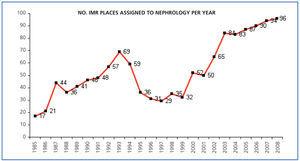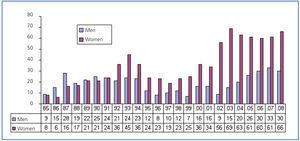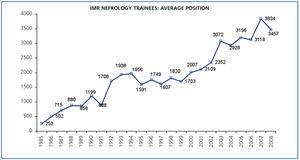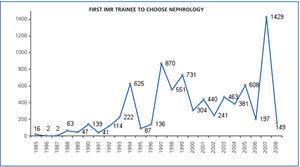This article reviews the trends in positions of internal medicine resident (IMR) assigned to nephrology in Spain from 1985 to 2008. We analyse the number of positions, the changes of average points received (435 to 377), and the average position for nephrology (253 to 3457). We also observed the distribution by sex for the candidates (from 42% to 72% feminisation) over the 24 years examined. Nephrology is positioned 29th of the 47 specialities offered on Spanish IMR training programmes. These data should be an indication to all nephrologists that change is needed. We must examine which factors are involved in the lessening interest in Nephrology as a career among medical graduates and then strive to resolve the problems.
Analizamos la evolución de las plazas asignadas a nefrología en la convocatoria MIR desde 1985 a 2008. Se recoge el número de plazas y se calculan la calificación media anual y el número de orden promedio. El número de plazas adjudicadas ha aumentado un 464% (de 17 a 96), con una progresiva feminización que llega al 72,5% en los últimos años. La calificación media anual de los candidatos ha disminuido de 435 a 377 puntos y el puesto medio de elección se ha ido retrasando del 233 al 3.457. Los datos sugieren una pérdida de atractivo de la especialidad que debe llevar a examinar y corregir los factores implicados.
INTRODUCTION
The future for nephrology greatly depends on developing programmes that appeal to potential candidates.1
Recently, access and training in the field of nephrology has aroused reflection both in Spain2,3 and overseas.4-6
In this study, we hope to contribute to the debate by providing concrete data concerning the number of internal medical residency (IMR) positions[1] assigned for nephrology in Spain during the past 24 years.
MATERIAL AND METHOD
Data concerning the openings awarded from 1895 to 2008 was provided by the Spanish Ministry of Health. Based on the broken down data, we calculated the average number of points for each year (including the average exam points and academic transcript) and the average position for nephrology. We collected data on the average position for the first and last junior doctor that chose nephrology each year, as well as the number of openings assigned to nephrology and distribution by sex.
RESULTS
Table 1 shows a summary of the data.
The number of positions assigned to nephrology has increased from 17 to 96, representing a 464% increase throughout the study period (Figure 1). There is a significant variation between sexes (Figure 2). Throughout this period, 65% of nephrology junior doctors were women. During the first 5 years, this percentage was 42.2% compared with 72.4% over the past 10 years, which seems to have stabilised.
The average annual number of points for positions awarded to nephrology has decreased from 435 to 377 points (Figure 3). The average position has a clear trend to be delayed, being 253 at the beginning of the period and 3457 at the end (Figure 4). The ranking position of the first junior doctor to choose nephrology has changed significantly (Figure 5). The ranking position of the last junior doctor has moved backwards, going from 937 position to 5485 position (Figure 6).
Table 2 shows the list of hospitals that have been requested by the top 5 IMR nephrology trainees during the study period.
DISCUSSION
The number of nephrology IMR openings awarded throughout this period has markedly increased until 2009. This 464% increase is in line with the general context of the specialist positions awarded within the Ministry of Health policy7 and the National Clinical Speciality Commissions.2 This increase has remarkably made this speciality one of three medical specialities that have increased the most.8 Recently, there has been a lack of nephrologists to cover the estimated needs2 and increasing demand was forecast in view of an ageing population.2,3 However, this specialist growth rate could continue, bringing with it a “surplus” of nephrologists, as described in González López Valcárcel and Patricia Barber’s latest 2009 report on the supply and demand of specialist doctors in Spain: 2008-2025.8 In this respect, the Speciality Commission has approved that the number of openings awarded be reduced. Calculating future needs is always a difficult task, resulting as an estimate,2,7,9 given that it is partly dependent on the number of active nephrologists and their age.2,7,8 However, it also depends on the ageing population and health priorities, meaning that there are several possible scenarios.
Regarding distribution by sex, there was a significant increase in the number of women choosing nephrology. Feminisation of the medical profession is a well recognised process that has grown stronger throughout the world over the past 30 years.9-11 Throughout the study period, 65% of IMR trainees were women. During the first 5 years, this percentage was 42.2% compared with 72.4% over the past 10 years, which seems to have stabilised. When considering the whole IMR population (i.e. all specialities), 80% of trainees are women.8 Nephrology training data for the USA show that 30% are women.5 European nephrology training data are considered within overall internal medicine data, showing a similar phenomenon.14 The total of active female nephrologists in Spain is 42.8%,8 being one of the highest ranking specialities, only coming after haematology (52%), general practice (49.2%) and paediatrics (60.1%).8 There are even more female nephrologists in France.13 A recent study has been published in the Spanish journal Nefrología on female integration and participation within nephrology in Spain.15
The average annual number of points for positions awarded to nephrology has decreased from 435 to 377 points (Figure 3). The ranking position of the first junior doctor to choose nephrology has changed significantly (Figure 5); and that of the last junior doctor has moved backwards, going from 937 position to 5485 position (Figure 6). All of these data show us that our speciality is becoming less and less attractive to young professionals. Nephrology is positioned 29th of the 47 specialities offered on the IMR training programme.8 It is astonishing to see that in the USA there is a difficulty to fill all of the nephrology training openings with American juniors, meaning that this speciality has the most foreign professionals (41%).5
In recent years, some specialities have had high drop out rates. In this respect, it seems that the drop out rate for nephrology programmes is low, being around 6%, which is similar to that of internal medicine (5.8%), lower than biochemical medicine (40%) and higher than cardiology (1.4%).8
Data concerning the ranking of the first junior doctor to choose nephrology (Figure 5) and most requested hospitals for the top 5 trainees are interesting, but they are quite incidental (Table 2.) Personal choice for these few positions could be influenced by multiple aspects, from the size of the centre’s population, whether there is a university with school of medicine, or the number of positions offered, amongst others.
In brief, our study suggests that this speciality is becoming less attractive in Spain, which is a common concern in other countries, as described in various studies.4-6,16 There are doubtlessly many factors involved, from the job market perspectives to the training programme’s content and methodology. Understanding the situation and the opinions of those involved is an important step forward.3,6 As nephrologists, we need to actively develop interesting programmes that appeal to motivated individuals, introducing innovation, enthusiasm, intensity and integrity.16
The way that we conceive medical training has changed, being based on assessing skills, new simulation techniques, and introducing evidence as a teaching tool.1,3,4,18 Although there are still very few publications about nephrology, there are opportunities for developing new teaching techniques. However, we must highlight that interventional nephrology has contributed interesting studies that link the learning process with outcome.19-21
EDITOR’S NOTE
The content of this article is without a doubt extremely important for the future of Spanish nephrology. The editors therefore invite Spanish nephrologists to send their opinions and observations on the matter, using the “Letters to the editor” format.
[1] Medicine graduates wishing to take part in an IMR training programme must sit an official exam. The mark of the exam is worth 75% of the final score, with an academic transcript taking up the remaining 25%. Candidates are then put on a ranking list and those with the most points have first choice of IMR speciality and the hospital where they will complete the programme. Medical graduates must complete IMR training to work in the public sector.
Table 1. Trends related to IMR nephrology places assigned (1985-2008)
Table 2. Summary of centres requested by the top five nephrology IMR trainees (1985-2008)
Figure 1. Trends related to IMR places assigned to nephrology (1985-2008)
Figure 2. Distribution by sex of IMR nephrology places assigned (1985-2008)
Figure 3. Average number of points for IMR nephrology trainees (1985-2008)
Figure 4. Average position for IMR nephrology trainees (1985-2008)
Figure 5. Nephrology IMR: trends related to first trainee to choose this speciality (1985-2008)
Figure 6. Nephrology IMR: trends related to last trainee to choose this speciality (1985-2008)






















